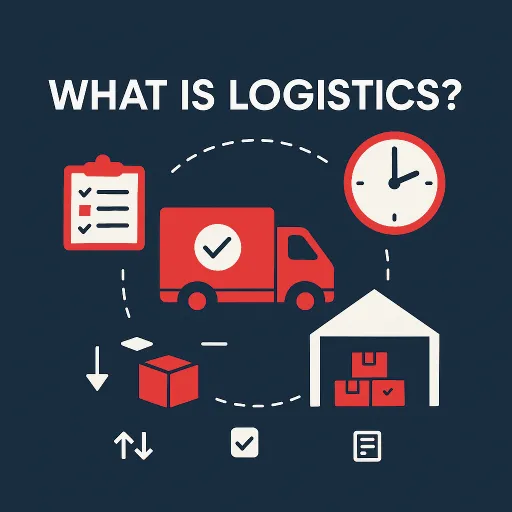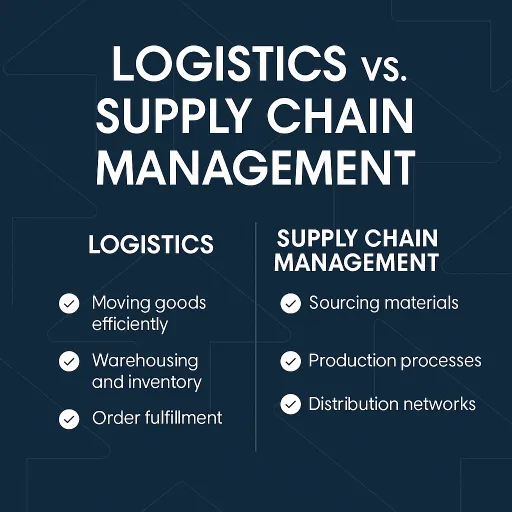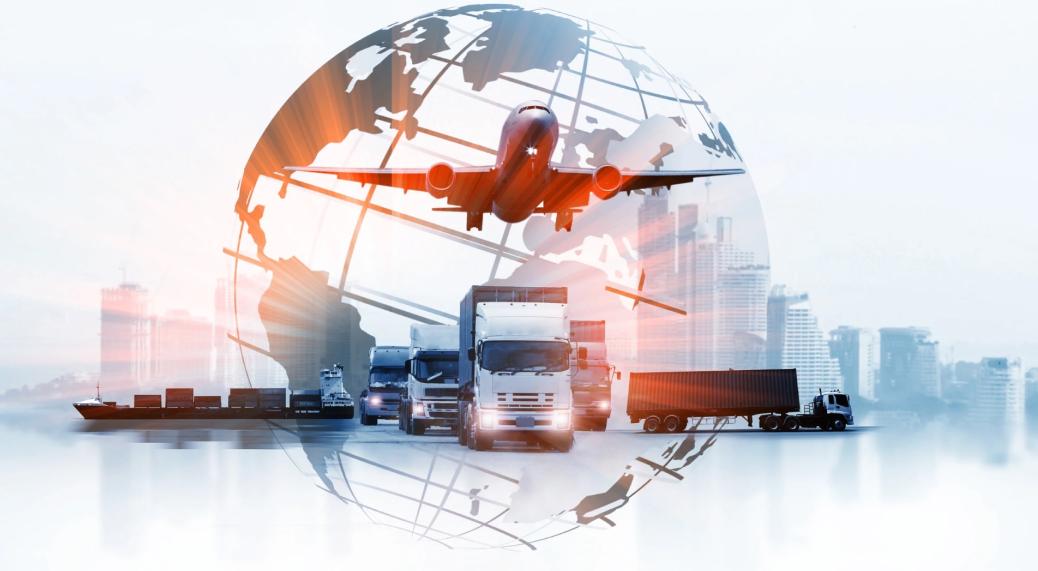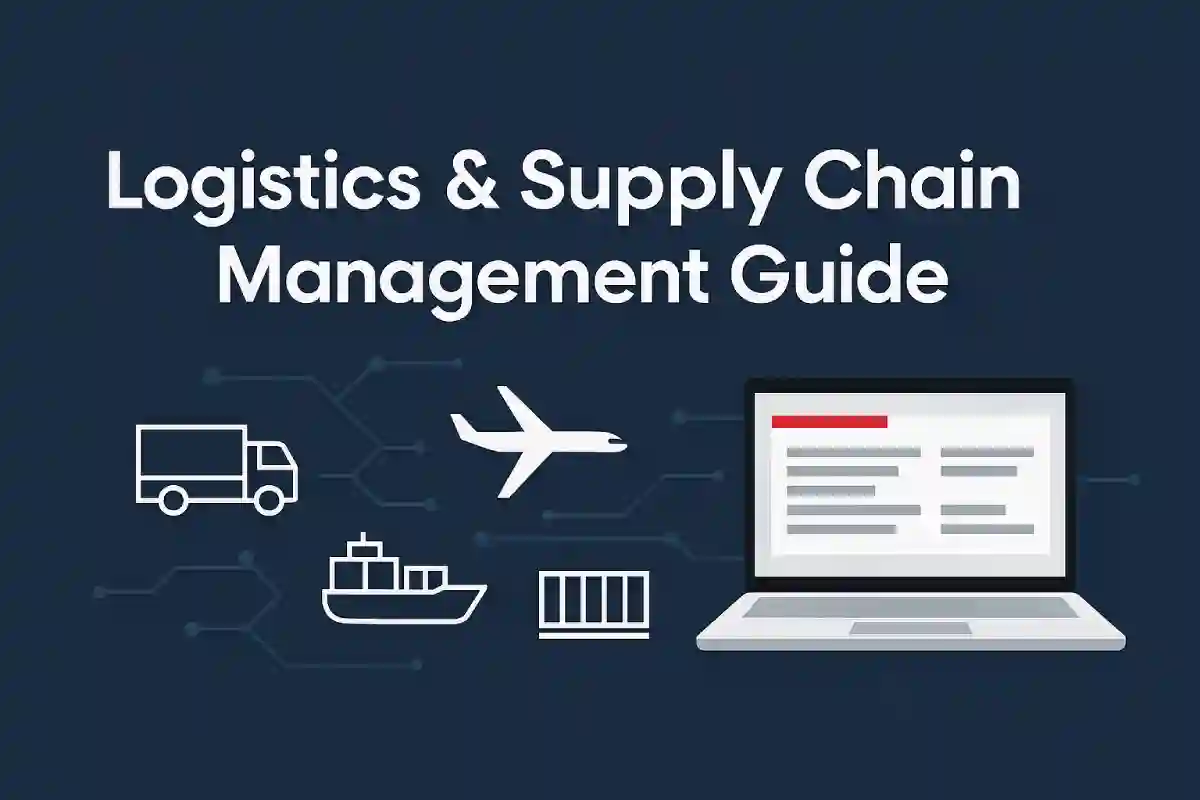.webp)
In today’s interconnected world, logistics is the engine that powers global trade and efficient supply chains. Whether you run a small logistics company or manage a large global logistics provider, the pressure to deliver faster, cheaper, and more sustainably has never been higher.
From logistics transportation to warehouse automation, modern logistics services require a blend of strategic planning, digital tools, and automation to remain competitive.
We will cover here the essentials of logistics and supply chain management, strategies to optimise operations, and the technologies shaping the future of transport and logistics.

What Is Logistics?
Logistics is the engine that keeps goods, materials, and information moving efficiently from their origin to the final customer. It’s not just about transportation — it’s about coordinating every step so the right product arrives at the right place, in the right condition, at the right time, and at the right cost.
This includes transportation, warehousing, inventory control, order fulfillment, packaging, and even reverse logistics for returns or recycling. When done well, logistics reduces costs, improves speed, and strengthens customer loyalty. When it falters, it can mean delays, extra expenses, and lost business.
In fact:
- Companies can cut operational costs by up to 25% through logistics optimisation.
- 65% of shoppers will buy from a competitor if their first choice is out of stock.
- Over 65% of businesses have reported revenue losses from logistics disruptions in recent years.
Logistics vs. Supply Chain Management
While logistics and supply chain management are closely linked, they’re not the same.
- Supply chain management is the bigger picture — covering sourcing, production, and distribution across multiple parties.
- Logistics management focuses on what you directly control: moving, storing, and delivering goods efficiently.
By improving logistics, you can stay competitive even when wider supply chain challenges arise.

Examples of Logistics in Action
- An e-commerce company using real-time inventory tracking to ship same-day orders.
- A global logistics provider coordinating sea, rail, and road freight to move products across continents.
- A business partnering with a 3PL logistics service to outsource warehousing and fulfillment.
Strong logistics means lower costs, faster delivery, and happier customers — all essential for competing in today’s global logistics market. It also builds resilience, enabling you to adapt quickly to supply chain disruptions or market changes.
Types of Logistics Services
1. Inbound Logistics
Inbound logistics manages the transportation, storage, and delivery of raw materials, components, and supplies from suppliers to your facility. It’s about ensuring production lines have what they need — exactly when they need it — without delays or excess stock.
Example:
An automotive manufacturer imports engine components from Germany, upholstery from Italy, and electronics from Japan. Inbound logistics coordinates ocean freight schedules, arranges customs clearance, and schedules final trucking to ensure parts arrive just in time for assembly.
2. Outbound Logistics
Outbound logistics covers getting finished goods from your facility to customers — including retailers, wholesalers, or direct consumers. It involves order processing, picking, packing, transportation, and last-mile delivery.
Example:
A furniture retailer ships assembled pieces from a central warehouse to customers across the country. Outbound logistics ensures orders are processed daily, trucks are loaded efficiently, and deliveries arrive within the promised time frame.
3. Reverse Logistics
Reverse logistics deals with moving products back from customers for returns, repairs, recycling, or disposal. A well-run reverse logistics process improves customer satisfaction, reduces waste, and supports sustainability.
Example:
An electronics company offers a recycling program for old laptops. Reverse logistics coordinates pickup, transport to refurbishing centers, and responsible disposal of non-reusable parts.
4. 3PL Logistics (Third-Party Logistics)
A 3PL logistics provider takes over part or all of your logistics operations. Services can include transportation, warehousing, inventory management, order fulfillment, and even customer service. Partnering with a 3PL allows businesses to scale faster without heavy capital investment in infrastructure.
Example:
A growing cosmetics brand outsources to a 3PL with multiple fulfillment centers in Europe. The 3PL stores the inventory, packs orders, and ships products to customers — cutting delivery times and costs.
5. 4PL Logistics (Fourth-Party Logistics)
4PL providers act as strategic partners, overseeing the entire supply chain, including managing multiple 3PLs. They focus on end-to-end optimization, technology integration, and supply chain strategy, often without owning physical assets.
Example:
A multinational electronics brand hires a 4PL to manage its supply chain across Asia, Europe, and North America. The 4PL coordinates multiple regional 3PLs, integrates logistics software for visibility, and negotiates carrier contracts to lower costs.
6. 5PL Logistics (Fifth-Party Logistics)
5PL providers specialise in large-scale, often global, e-commerce and omnichannel operations. They leverage advanced technology, data analytics, and automation to manage the supply chain from procurement to final delivery — focusing on efficiency, scalability, and cost reduction.
Example:
A major online marketplace uses a 5PL to oversee procurement, inventory placement across continents, automated warehousing, and AI-driven route optimization — enabling millions of daily deliveries with minimal delays.
Key Challenges in Modern Transport & Logistics
Rising Fuel Costs and Transportation Budgets
Fuel is one of the largest and most unpredictable costs in logistics transportation. With global oil price fluctuations, transport budgets can swing dramatically, cutting into margins and forcing companies to raise rates or absorb losses. For fleets operating at scale, even a €0.10 increase per liter can translate into millions in added costs annually. Beyond pure expenses, rising fuel costs can destabilise long-term contracts and make forecasting more difficult.
For example in 2022, European transport operators saw overall costs rise by more than 20% due to soaring fuel prices, pushing many small carriers to the brink.
How to act:
Companies are turning to route optimisation software, TMS solutions, and fuel usage tracking to cut waste and maximise efficiency.
Stricter Environmental Regulations
Sustainability is no longer a buzzword — it’s law. Global logistics companies must now comply with increasingly strict environmental regulations, from urban low-emission zones to international carbon reporting frameworks. These rules affect everything from fleet composition to delivery schedules. The shift is urgent: the EU’s “Fit for 55” package requires a 55% reduction in CO₂ emissions by 2030, which means logistics providers must modernise operations today to stay compliant tomorrow. Non-compliance isn’t an option — fines, reputational risks, and lost contracts are on the line.
How to act:
Transitioning to greener fleets takes time, but immediate steps like smart load planning, fewer empty runs, and carbon footprint tracking are achievable today.
Driver Shortages and Workforce Challenges
The logistics sector is facing a workforce crisis. Across the globe, companies report severe driver shortages, with retirements outpacing new entrants and younger generations reluctant to take on demanding long-haul roles. This shortage leads to delayed deliveries, higher labor costs, and increased pressure on existing staff. The problem isn’t going away soon — the International Road Transport Union estimates the global driver shortfall could reach over 2.6 million by 2026. Combined with a lack of warehouse staff in many regions, the human factor has become one of the industry’s biggest bottlenecks.
How to act:
Logistics companies can ease the pressure by automating repetitive tasks, digitising trip sheets, and optimising driver schedules.
Demand for Real-Time Tracking and Transparency
Customers no longer tolerate vague delivery windows or a lack of visibility. They expect real-time tracking from the moment they place an order to final delivery, regardless of whether the shipment is domestic or international. Transparency has become a standard, not a luxury — driven by e-commerce giants like Amazon that set the bar for instant updates. Businesses that cannot match these expectations risk losing clients, facing higher support call volumes, and damaging their reputation. In a global survey, more than 80% of B2B buyers said real-time shipment visibility is a top factor when choosing a logistics provider.
How to act:
Meeting these demands requires IoT integrations, live dashboards, and automated status notifications.
Supply Chain Disruptions and Inventory Risks
Few industries felt the impact of recent crises more than logistics. Events like the COVID-19 pandemic, geopolitical tensions, extreme weather, and the Suez Canal blockage revealed just how fragile global supply chains can be. Disruptions ripple quickly: containers pile up at ports, warehouses run out of stock, and production halts. For logistics companies, these risks translate into missed deadlines, angry customers, and significant revenue loss. The Suez Canal blockage alone in 2021 held up nearly $10 billion worth of global trade per day, underscoring how one weak point can paralyse entire industries.
How to act:
The key is resilience: diversifying suppliers, using predictive analytics, and building regional hubs.
Strategies for Effective Logistics Management
Route Optimisation
Getting from point A to point B sounds simple, but in logistics, poor routing translates directly into lost time and wasted money. Inefficient paths increase fuel consumption, lead to late deliveries, and reduce driver productivity. Modern route optimisation software considers factors like live traffic, delivery time windows, and vehicle capacity to ensure every trip is cost-effective.
👉 Research shows companies that implement advanced routing solutions can cut fuel consumption by up to 15% and increase on-time delivery rates significantly — a competitive edge when customers expect precision.
Demand Forecasting
Predicting demand is one of the hardest parts of logistics — but also one of the most rewarding. Businesses that rely on guesswork often swing between overstocked warehouses and empty shelves. Forecasting powered by data analytics allows companies to anticipate seasonal spikes, market trends, and customer preferences with greater accuracy.
👉 Companies using advanced demand forecasting reduce inventory errors by 20–50%, resulting in fewer stockouts and lower emergency shipping costs.
Lean Logistics
Lean logistics is about trimming the fat from operations. Every delay, idle vehicle, or duplicated process adds cost without adding value. By applying lean principles, businesses can redesign workflows, cut unnecessary steps, and speed up throughput.
👉 Consider a warehouse that reorganises its layout so best-selling items are stored closer to packing stations. The change sounds small, but it can save hundreds of labor hours per month — directly boosting efficiency without new investments.
Automation in Logistics Services
Manual processes slow things down and are error-prone — especially at scale. In logistics, automation means more than robotics; it’s about digitising the everyday: instant shipment notifications, automated document generation, and touchless invoicing. This allows staff to focus on problem-solving instead of paperwork.
👉 A study by Deloitte found that automation can reduce processing costs by up to 30%, while increasing order accuracy and customer satisfaction.
Collaboration & Visibility
One of the biggest challenges in logistics is that multiple players are involved — suppliers, carriers, warehouses, distributors — and each has its own systems. Without strong collaboration and visibility, critical data gets stuck in silos. A lack of transparency leads to missed opportunities for cost savings and slower responses to disruptions.
👉 Gartner research ranks visibility as one of the top three strategic investments for supply chain leaders—nearly 46% of organisations are prioritising it as a key initiative. Increased visibility helps teams resolve issues proactively, leading to better delivery performance and improved customer experience.
Sustainability in Logistics
Sustainability has moved from a corporate “nice-to-have” to a business necessity. Customers expect greener operations, regulators demand compliance, and inefficiencies are increasingly costly. Logistics companies are reducing emissions by investing in electric fleets, optimising packaging, and minimising empty runs.
👉 Companies that prioritise green logistics not only reduce emissions but also lower costs by 5–10% thanks to smarter fuel use and resource efficiency. Sustainability is no longer just about image — it’s about resilience and profitability.
Technology in Transport & Logistics
Modern logistics is no longer just about moving goods — it’s about moving data just as efficiently. Today’s logistics providers rely on advanced digital tools to gain visibility, cut costs, and meet growing customer expectations. Technology enables real-time tracking, faster communication, and smarter decision-making across the entire supply chain. Companies that invest in logistics tech see higher efficiency, lower operational risks, and stronger customer loyalty.
Transportation Management System (TMS)
A Transportation Management System is the backbone of logistics operations. It centralises planning, execution, and monitoring of all transport activities.
Key features:
- Real-time shipment tracking with GPS
- Automated trip sheets and smart route planning
- Fuel and expense monitoring
- Load optimisation to minimise empty runs
- Integration with freight exchanges
- Alerts for delays, downtime, or compliance risks
How it helps:
A TMS ensures on-time, cost-efficient deliveries while giving managers full control over fleet performance. Companies using TMS often cut transport costs by up to 15%.
Warehouse Management System (WMS)
A Warehouse Management System keeps goods flowing smoothly through storage facilities and reduces inefficiencies.
Key features:
- Real-time inventory control with barcode/RFID scanning
- Smart space utilisation and warehouse layout planning
- Automated picking, packing, and dispatch
- Multi-warehouse visibility from one dashboard
- Seamless e-commerce integration
Real-world WMS improvements in logistics are substantial:
- Inventory accuracy exceeds 95% in organisations using digital tracking and real-time visibility, significantly reducing stockouts and excess inventory.
- Picking speed improves by up to 30% when warehouses adopt optimised layouts and real-time inventory monitoring.
- Facilities integrating automation with WMS regularly achieve 99%+ fulfillment accuracy and maintain on-time, in-full (OTIF) delivery rates above 98%, strengthening customer satisfaction and loyalty.
Logistics CRM
A Customer Relationship Management system for logistics builds trust and transparency with clients by linking directly to shipment data.
Key features:
- Automatic cargo status notifications (via email, SMS, or WhatsApp)
- Centralised client database with full history
- Smart quoting and invoicing tied to shipments
- Call and ticket logging for accountability
- Client portals for real-time tracking
How it helps:
A logistics CRM reduces support calls, increases transparency, and improves customer loyalty. Clients stay informed automatically, which leads to higher satisfaction and retention.
AI & Predictive Analytics
Artificial Intelligence turns logistics data into actionable insights, helping companies move from reactive problem-solving to proactive planning.
Key capabilities:
- Forecast demand for precise inventory planning
- Predict maintenance needs to prevent breakdowns
- Anticipate delays using weather, traffic, and route data
- Optimise scheduling and load distribution automatically
- KPI dashboards with real-time performance metrics
How it helps:
AI reduces forecasting errors by 30–50% and boosts service levels by up to 65%, helping logistics companies stay one step ahead of disruptions.
How It All Works Together
Technology in logistics isn’t just about individual tools — it’s about building a connected ecosystem:
- TMS plans and executes the transport.
- WMS ensures inventory is stored, picked, and dispatched efficiently.
- CRM keeps clients informed with real-time updates and transparent communication.
- AI & Predictive Analytics optimise every step, ensuring smarter decisions and fewer disruptions.
Together, these systems create a digital logistics pipeline where every stage — from order to final delivery — is visible, automated, and optimised. This integrated approach reduces costs, improves speed, and gives logistics providers the competitive edge needed to thrive in global markets.
Benefits of Logistics Optimisation
Cut Operational Costs (10%–25%+)
Independent studies and real-world examples reveal that logistics optimisation can deliver substantial cost reductions—often between 10–25%, depending on the strategy, scope, and implementation.
Independent studies suggest that logistics optimisation can cut freight and operational costs by 15–27% on average, with some businesses reporting savings of over 40% depending on the maturity of their supply chain.
Increase Delivery Speed and Accuracy
Streamlining logistics processes not only cuts costs, but it also improves both the speed and accuracy of delivery. While exact figures for delivery improvements weren’t in these case studies, many of the same technologies—like TMS systems used to consolidate carriers and automate routing—are known to improve on-time and in-full delivery rates. For example, by integrating better transportation systems, organisations have gained greater control over outbound freight and reduced errors, translating to improved service quality.
Improve Customer Satisfaction and Retention
Reliable, efficient logistics builds customer trust. When deliveries are accurate and transparent, satisfaction and loyalty rise. While specific satisfaction metrics aren’t always reported publicly, automation and visibility tools that enable proactive customer communication and reduce errors are proven to elevate the customer experience—resulting in stronger retention and positive reputation in B2B environments.
Achieve Sustainability Goals Through Emissions Reduction
Optimised logistics isn’t just about efficiency—it’s about planetary impact, too. GEODIS, for instance, reported that its retail consolidation services (RCS)—combining less-than-truckload shipments into full-truckload deliveries—cut carbon emissions by up to 13% through fewer miles traveled and smarter route planning. Meanwhile, a major 3PL using EcoTrack software managed to reduce emissions by 12% within one year by identifying and tackling logistics inefficiencies.
The Impact of Logistics Optimisation
- Cost Savings: These documented reductions—ranging from 10% to 25% in freight costs—can transform your logistics budget.
- Faster, More Reliable Deliveries: Cleaner workflows and smarter routing lead to fewer mistakes and more consistent service.
- Customer Loyalty: Transparent, dependable logistics operations help retain clients and reduce support overhead.
- Stronger Sustainability and Compliance: Real-world emissions reductions (12–13%) help meet green regulations and resonate with eco-conscious partners.
How to Choose the Right Logistics Provider
Selecting the right logistics company or 3PL logistics partner can make the difference between smooth, cost-efficient operations and ongoing delays, hidden fees, and frustrated customers. With so many providers competing in the market, it’s important to look beyond promises and focus on measurable value. Here are the key factors to consider:
Proven Expertise in Logistics and Supply Chain Management
Experience matters. A reliable logistics provider should demonstrate deep industry knowledge, case studies, and a track record of solving challenges similar to yours — whether it’s handling international freight, managing complex supply chains, or navigating strict compliance rules.
👉 Ask for references and proof of success. For example, a provider that has helped manufacturers reduce inbound delays or supported e-commerce retailers with fast last-mile delivery shows they understand your industry’s specific needs.
Integrated Technology Platforms
In today’s world, logistics runs on data. The best providers don’t just move goods — they provide real-time visibility through advanced tools like TMS, WMS, and logistics CRM systems. These platforms ensure you can track shipments, analyse performance, and automate updates to customers.
👉 According to Gartner, 75% of supply chain leaders expect digital ecosystems to be the key driver of competitiveness by 2026. If your provider isn’t equipped with integrated tech, you risk falling behind.
Scalability to Grow With Your Business
Your logistics partner should be able to scale with you — from handling a few weekly shipments today to managing thousands tomorrow. Look for providers with flexible capacity, multiple warehouse locations, and international reach if you plan to expand globally.
👉 Many fast-growing companies hit bottlenecks when their logistics provider can’t keep up. A scalable partner ensures growth opportunities aren’t held back by operational limits.
Transparent Pricing and KPIs
Hidden fees and unclear reporting are red flags. The right logistics provider offers clear contracts, upfront pricing models, and performance dashboards so you can measure results. Key performance indicators (KPIs) like on-time delivery rate, order accuracy, and cost per shipment should be transparent and accessible.
👉 Transparency not only builds trust, it also empowers you to make better decisions. If a provider can’t explain their cost structure or share performance data, it’s time to look elsewhere.
For inspiration, explore our guide to the Top Freight Forwarders in 2025, where we highlight the companies setting global standards in logistics performance.
Future of Global Logistics
1. Autonomous Transportation for Long-Haul Routes
The shift toward autonomous trucks is rapidly moving from experimental to mainstream. Companies like Einride are already operating driverless trucks on public roads in Sweden, while Aurora Innovation, in collaboration with DHL and Volvo, is deploying self-driving freight services between Dallas and Houston. These trucks use AI, lidar, and radar for 360° vision to navigate highways safely.
Forecast: McKinsey estimates the autonomous trucking industry could generate $616 billion in revenue by 2035.
2. IoT Sensors for Shipment Tracking
The IoT logistics market is expanding rapidly: from around $44.6 billion in 2022, it is expected to reach $125.9 billion by 2031, driven by demand for real-time tracking, predictive maintenance, and route optimisation.
These sensors—encompassing RFID, GPS, and cloud-connected devices—are helping logistics providers reduce breakdowns, improve inventory accuracy, and enhance visibility across the supply chain.
3. Sustainable Logistics Services to Reduce Carbon Footprints
Sustainable logistics is no longer optional—it’s essential. With growing environmental regulations and customer expectations, companies are turning to green distribution strategies like eco-packaging, optimised load planning, and reverse logistics to lower emissions.
These practices heighten both operational efficiency and brand credibility, especially when partnering with environmentally conscious shippers and consumers.
4. Blockchain for Secure, Transparent Documentation
Blockchain is emerging as a key enabler in logistics, offering tamper-proof ledgers for tracking shipping histories, automating smart contracts, and safeguarding documentation integrity—especially for complex, multi-party supply chains.
Market growth: The blockchain-in-logistics market is projected to grow from $2.65 billion in 2023 to $19.2 billion by 2032, at a CAGR of 24.6%.
Use cases include Walmart’s lettuce tracking trials, Everledger’s diamond provenance system, and Mercedes-Benz’s supplier emissions tracking.
Summary Flow: How These Trends Intersect
- Autonomous trucks simplify long-haul operations while addressing driver shortages.
- IoT sensors enable real-time visibility and operational intelligence.
- Sustainable logistics solutions ensure compliance and boost brand reputation.
- Blockchain secures data and builds trust across global supply chains.
Together, these emerging technologies are forging the next generation of global logistics—automated, transparent, resilient, and sustainable.




